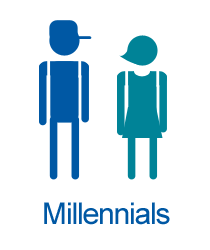Making a Positive, Creative, and Productive Workplace
Diversity in the workplace is more than characteristics like gender, ethnicity, age, education, and tenure; it’s about how people view themselves and the people they work with. This lays the foundation for how people interact in the workplace.
Successful workplaces will have to become more diverse over time, so it only makes sense to embrace it in your organization. It will help your business grow and remain competitive. Bringing youth on board is one way you can diversify and prepare for the future.
Tap into Talent
As an employer in Nova Scotia, chances are you’re finding it harder to find workers than ever before. Baby Boomers, those born between 1946 and 1964, make up 46 percent of the workforce. As they retire the generation that follows makes up just 30 percent of the workforce. Moving forward there will not be enough skilled people to replace them.
Looking to diverse and underrepresented groups as a source of new employees is an effective way to address recruitment challenges and skills shortages. There’s a wealth of skilled and talented people in Nova Scotia who are not effectively engaged in the workforce. Youth, mature workers, persons with disabilities, African Nova Scotians, Aboriginal Peoples, the immigrant workforce and others are often overlooked and their talents are wasted either by not hiring them or by under employing qualified candidates.

Employers who tap into the full potential of the province’s workforce by building a welcoming and inclusive work environment are poised to better attract and retain workers and compete more effectively than those who remain unprepared.
Diverse workers benefit your company by bringing a unique and beneficial blend of skills, abilities, and perspectives to your workplace. Diversity can, in fact, make it easier for your company to understand and strategically respond to the marketplace and the needs of your clients. A workforce of diverse people can help you find a wider range of solutions for the business challenges you face every day.
Recognize the Individual, Not the Generation
The media often describes youth as a self-entitled, narcissistic generation, whose helicopter parents constantly buzz around them and intervene. But is that actually true? You’ll always find someone willing to offer anecdotal evidence, however, it’s worth looking at the truths over the myths.
Select each myth, to discover the truth.
Younger workers work hard and often do the grunt work; but, it needs to be connected to the overall plan. Once they’ve done it, they’re ready to move forward. Managers who have worked for years to see advancement may not relate to the desire to advance quickly.
Job satisfaction is important to younger workers: they want to do a good job. Regular positive, honest feedback will keep them on track and motivated.
Younger workers who are challenged and treated fairly, and who see opportunities with their employers are much more likely to stick around.
Younger workers do tend to use technology a lot, but their ease with technology can have benefits for your organization. In fact, they often use technology to find information that helps them do their jobs faster.
All employees need to connect with their inner motivation, and good managers figure out how to get their employees motivated, regardless of age. Taking the time to talk with younger employees will give managers a lot of clues about how to
inspire them.
Younger workers don’t see the value of working extremely long hours and sacrificing their time with family and friends. They’re more likely to avoid careers that expect them to do so, or that treat employees as a commodity. Employers should work to motivate younger workers and to help them recognize the value of the work they do.

Alex Henderson
Canada Games Centre Society
"I believe a myth around youth workers is that they're inexperienced or they're irresponsible or things along those lines. But I think it’s a myth because some companies just don't give the opportunity. We want to gain experience, we want to learn, and we're willing to do whatever it takes to get there."

Alexia McGill
Agenda Managers
"Another myth is that they lack work ethic. The students that we have hired, they show up early, they have to stay late, they have to work weekends. There's a lot of work in a very short time, sometimes, that we must accomplish to meet our deadlines, and these students always show up with a smile on their face and happy to do the work."
Expand Your Capabilities
Workplaces in all sectors can benefit from employing a diverse workforce. A diverse group will bring individual skills and experiences that can help your business innovate and solve problems. When you support diversity and inclusion, you encourage employees to be engaged.
By building a diverse team that includes youth, you:
- Can draw from a wider range of ideas and experiences
- Share your organizational values
- Open the potential to offer a broader range of services
- Can connect with more customers
- Have a strategy for identifying and shaping future leaders
- Minimize the risk of a skills shortage from an aging population and upcoming retirements
Consider Hiring an International Student
By hiring an international student, not only are you hiring an educated employee, but you are gaining a whole new perspective on your team. You can hire eligible students while they study or after they graduate.
Check the Canadian Immigration and Citizenship (CIC) website for details about the guidelines and eligibility.

Employees are Engaged When They Can Be Themselves
A diverse workplace doesn’t just happen on its own, or without challenges. When you bring together a group of people with different experiences and ideas, there is bound to be some level of conflict. To be effective, celebrate diversity and build it into your company’s culture. Your leaders also play an important role in setting the example. They must allow for open communication and fairness around any issues.
Each generation has different situations in which they grew up. Historical events and the types of technologies at the time can impact perceptions, behaviours, and communication styles. While there are some common themes for each generation, employees can’t be categorized based on their birth year alone.
Despite any differences, each generation can learn and grow from each other:

Older workers, known as Baby Boomers:
- Make great coaches and mentors for younger workers
- Have wisdom about economic cycles and provide a long-range view of things
- Know what it means to commit through thick and thin
- Readily share what they know about policies, industry knowledge, people, jobs, and success
- Can teach basic workplace interpersonal skills such as common courtesy and team play

Middle-aged workers, known as Gen-X:
- Support independence and resourcefulness
- Adapt well to change
- Appreciate fun in the workplace
- Value work-life balance
- Support diversity and alternative lifestyles

Younger workers, known as Millennials or Gen-Y:
- Offer a wealth of technology-related information from which peers can benefit
- Know how to use social media to leverage opportunities
- Bring a fresh enthusiasm to their jobs, and can help others see things in a new light
- Challenge the status quo compared to people who have spent their careers respecting corporate hierarchies
Make Diversity Your Policy
A great way to share your support for diversity is to include it in your policies. By creating a workplace diversity policy, you:
- Show your commitment to equality through practical strategies
- Create guidelines for fairness that all employees can access
- Are clear about how issues should be handled and resolved
- Reinforce your support of human rights laws
Ideas for Embracing Diversity in the Workplace
- Practice diversity in your recruiting and hiring.
- Get to know your employees and let them get to know each other. Create on-site and off-site activities that will foster this.
- Create common areas where employees can connect with each other throughout the day.
- Be as flexible as possible in your scheduling, to allow employees to better manage their work and personal commitments.
- Be inclusive and ask employees to give their input.
- Respect and trust what your employees say they need in order to do their best work.
- Look for opportunities to partner younger and older workers.
- Train your managers on how to coordinate a diverse team and to action the amazing outcomes generated by the team.